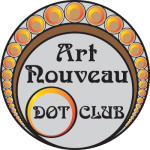Probably the six most popular art nouveau artists ever
These are the six most popular artists of Art Nouveau (1890-1914), which takes different names depending on its host country.
1. ALFONS MUCHA (1860-1939)
Probably the most popular one. The Czech painter excellently expressed the sense of the new way of making art that had touched major European cities in the late 19th century.
Mucha’s advertising posters for theaters achieved great success thanks to actress Sarah Bernhardt, who commissioned the artist to create posters for her shows.
In addition to the advertising aspect, Mucha also cultivated the visual one. Among his most famous graphics are the four seasons, personified by beautiful female figures surrounded by flowers and elegant frames with harmonious shapes.
2. VICTOR HORTA (1861-1947)
Although Henry Van de Velde can be considered the initiator of Art Nouveau. However, the first real interpreter of this new artistic current in Belgium was Victor Horta.
He taught architecture at the University of Brussels and soon became famous for his architectural designs. His most impressive work was the famous “House of the People,” which unfortunately was destroyed in 1966.
This iron construction featured a concave façade embellished with decorative stone and glass elements.
The Hôtel Solvay can also be considered a true masterpiece created by Horta.
The dwelling features fine details and a facade embellished with a sinuous wrought-iron balcony. So Horta more than met the standards set by Art Nouveau.
3. HECTOR GUIMARD (1867-1942)
Staying in the architectural sphere, we leave Belgium and move to France. Here we find a third exponent of Art Nouveau, Hector Guimard, who came to the new style after meeting Van de Velde.
From 1895 onward, Guimard became an advocate of Art Nouveau. His buildings faithfully adhered to the rules of the new trend; in fact, they featured precise structural elements, such as an open floor plan, iron details, shaped walls, and curved lines of furnishings.
Guimard’s most important works include the majestic “Castel Béranger” and the entrances to the Paris metro stations.
The building features a curious decorative element, namely the wrought-iron gate with irregular curved lines, while the entrances to the metro are made of painted cast iron.
4. OTTO WAGNER (1841-1918)
Otto Wagner can be included among the major exponents of the Austrian Art Nouveau style, which took the name Jugendstil.
The Viennese architect worked on urban buildings, designing the old subway pavilion, the “Postsparkasse” (the post office) and the “Am Steinhof” church.
In all his works Wagner expresses his secessionist stance on an artistic level, thus repudiating the old academic dictates in favor of a total work of art that fuses different creative skills into a single product.
The meeting of different arts can be clearly seen in his achievements, rich in materials and contrasts between heavy and light masses. The harmony of forms and materials makes the most of the new trend that was taking hold in Europe between the nineteenth and twentieth centuries.
5. GUSTAV KLIMT (1862-1918)
Among the painters and leading exponents of Art Nouveau supporting the artistic secession we find Gustav Klimt.
The son of a skilled Austrian engraver, Klimt found himself working with gold and employed it as decoration for many of his paintings. The famous masterpiece “The Kiss,” a work rich in colors and shapes typical of the Jugendstil, is embellished by the use of this shiny yellow metal.
Gold as a decorative element became the leitmotif that fueled the so-called Golden Age. This artistic phase would later be abandoned by Klimt in later years in favor of a purely expressionist style dominated by chromatic variety.
6. ANTONI GAUDÍ (1852-1926)
The Catalan architect, a representative of Modernisme (the designation for Catalan Art Nouveau), created splendid works, most of them (but not all) in the city of Barcelona, which are still admired today by many thousands of tourists from all over the world.
Gaudí’s buildings have very unusual forms, totally unrelated to the traditional architectural style. Casa Batló and Casa Milá are magnificent examples of buildings with soft, curved forms.
The skillful use of convex and concave spaces make them resemble rock formations shaped by the sea and the action of the wind
Gaudí also expresses his art grandly with the Sagrada Familia and Park Güell. The masses shaped and enhanced by color suggest that the author fused painting, sculpture and architecture into a single art.
Do you want to be updated on Art nouveau beyond visiting this page from time to time? Three sources of info:
-
- Twitter account updated regularly: CLICK HERE!
- Linkedin group, a must for professionalsl looking for networking: CLICK HERE!
- An amazing Pinterest library to get inspired by Art Nouveau is this one: CLICK HERE!
